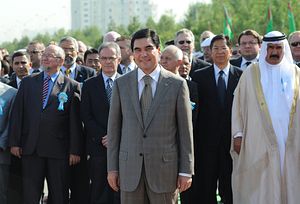Recommended weekend Central Asia reading:
Turkmenistan Military Drills, Cue the Music: As Joshua Kucera detailed early this week for Eurasianet, Turkmenistan began “unprecedented large-scale, unannounced exercises” last weekend. Official accounts say that the drills include every branch of Ashgabat’s military. RFE/RL’s Turkmen Service has clips of Turkmen state television broadcasts, featuring soldiers jogging to their rifles, a clip of a naval vessel in the Caspian, and requisite shots of President Gurbanguly Berdimuhamedov in camo: greeting soldiers, driving a car, driving some sort of armored 4×4, and apparently flying a helicopter. On the serious side, given the country’s border with Afghanistan and the persistent rumor that conflict there is imminent, the drills reportedly spooked some who took the increased presence of soldiers and military vehicles as a sign that the war had finally started.
Tajikistan’s Soviet War Vets: Keeping with the military theme for a moment longer, this piece from Markus Göransson on Open Democracy discusses the battle for recognition by Tajik veterans of the Soviet Union’s war in Afghanistan. Twenty-seven years after the decade-long war’s end, between 6,000 and 7,000 afgantsy still live in Tajikistan (about 15,000 residents of Soviet Tajikistan participated in the war). Göransson details their ongoing struggle to “carve out a place for themselves in post-Soviet Tajikistan.” Despite their efforts to link their service to present national patriotic narratives and the much celebrated history of the Soviet heroes in World War II, “the government’s response has been tepid.”
Kazakhstan’s Training Cafe: Joanna Lillis, for Eurasianet, visited a cafe in Almaty that is working to destigmatize and integrate those living with developmental disabilities and mental disorders. These groups, Lillis writes, “are largely invisible in Kazakhstan” where the prevailing norms follow Soviet systems of institutionalization. It’s a nascent but nonetheless inspiring project.
Conversation with U.S. Ambassador to Uzbekistan: Voice of America’s Navbahor Imarova sat down with Pamela Spratlen, the present U.S. ambassador to Uzbekistan, for a discussion of her first year in Tashkent. Spratlen–whom at least one Uzbek official apparently complimented as having been “aggressive” in getting what she wants done–provides a well articulated view on how the United States presently views its relationship with Uzbekistan. She’s diplomatic–that’s her job, after all–and while she doesn’t outright avoid difficult questions on security, corruption, forced labor in the cotton industry, and other tensions in the relationship, Spratlen’s responses are measured to avoid language Tashkent might overly object to. It’s not in the transcript, but listen in particular for Spratlen’s response to the question of whether the Uzbek government should actively engage the Cotton Campaign, an NGO initiative trumpeting forced labor issues. Spratlen says,”While I think there could be a constructive role to be played by talking to the Cotton Campaign, it’s up to them [the Uzbek government] to decide who their interlocutors are going to be.”
Another must listen: RFE/RL gathered the Majlis last week to discuss the always-interesting topic of succession in Central Asia.

































